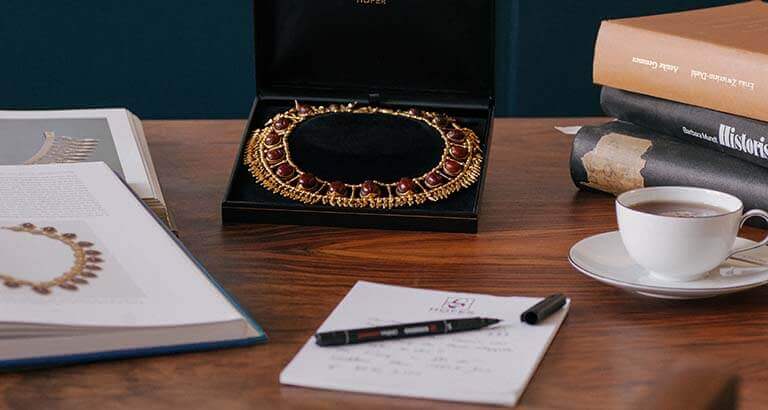ntique jewellery tells stories” is the central idea of Hofer Antikschmuck. Yet how do we go about unravelling the stories behind a glistening Art Deco ring or a mysterious scarab necklace of the 19th century? How do we get the objects of the past to speak?
We examine each piece of jewellery in the greatest detail, looking at it from different angles and through the eyes of the historian. Often, first clues as to its date are quickly found: is it an Art Deco object or is it from the 19th century? How well preserved is it? And of course, what is it? The function of a ring or brooch is easily explained. However, you can recognize a “tussie mussie” bouquet holder from the Victorian era only if you are aware of its function and existence.
Much that cannot be discerned on a first quick look is disclosed upon a second, closer one. Have individual gemstones been replaced or added, do they vary in cut or colour from the rest? Are there any older repairs or additions that differ in material or detail? Does the technique of the settings or the processing of the metals correspond to the era which the design of the piece suggests as the time of origin? Finally, we also verify the metals, the gemstones and all the details individually and thoroughly: not only through a magnifying glass, but also with gemological methods, with test acids and much more.
This is because we want to document all special peculiarities and also all traces of time on our pieces of jewellery in order to present their stories as completely as possible.
Having completed all this, we decide upon whether a piece will be photographed and presented on our shop, or whether it must first be passed on to one of our specialised partners. After several generations a gemstone may have loosened and will have to be re-set before the jewellery can be worn again. Likewise, there may be changes that we would prefer to take back in order to restore the piece as closely as possible to its original condition. In these cases, we work with goldsmiths and gemstone setters here in Berlin as well as with gemstone cutters in Idar-Oberstein and external gemological laboratories throughout Germany.
Such changes will always be documented and labeled in the descriptions of any given piece.
Equipped with this information about the material, the condition and design of the piece of jewellery, the task at hand is to assign a date to the ring, brooch or necklace and to place it within its historical context. To do so, we compare it to other pieces, to examples from literature and museums. Not unlike when examining a painting or a valuable sculpture, comparison helps us to understand what the special features of a piece of jewellery are, which of its features are typical of the time and of the fashion under which it was created.
Over the years, we have built up a specialised library on the history of jewellery. Often, consulting our books will be the first step of our research – for example, to learn about an unusual technique or a fashion that has been forgotten today. However, illustrations can rarely replace the actual three-dimensional objects. That is why we regularly visit the collections of the museums here in Berlin and throughout Europe. Moreover, we are a member of various associations that are dedicated to the history of jewellery and gemology.
In our team, we frequently discuss the special features of our most recent acquisitions and assess our findings together. This creates a lively discussion and the result is almost always a collaborative piece of teamwork.
Finally, we present the piece of jewellery to you on our homepage. We have every piece of jewellery photographed from all sides in order to give you a comprehensive view and give your the best possible idea of how a jewel will look when you receive it. Each piece is photographed on a model as well, in order to give a better understanding of its size.
In addition to the photographs, we also describe each of our jewellery pieces in a written text and record the material and dimensions, history and condition as detailed as possible. You will receive all this information along with the piece after purchase: a printed certificate with a picture of the object accompanies every package that leaves our office, so that the history of the jewellery can be preserved for future generations.






